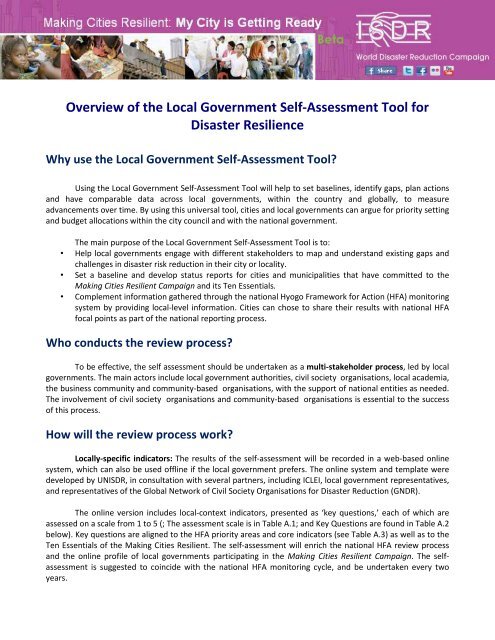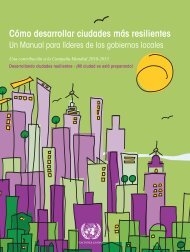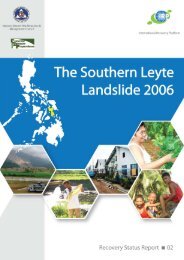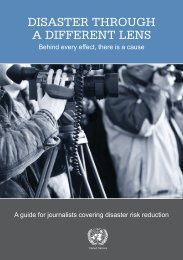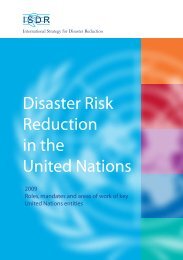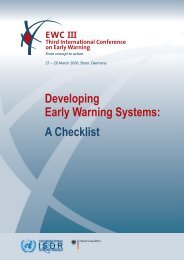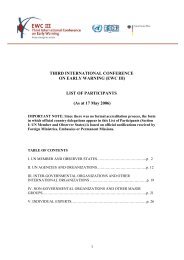Overview of Local Government Self-Assessment Tool (LGSAT
Overview of Local Government Self-Assessment Tool (LGSAT
Overview of Local Government Self-Assessment Tool (LGSAT
Create successful ePaper yourself
Turn your PDF publications into a flip-book with our unique Google optimized e-Paper software.
<strong>Overview</strong> <strong>of</strong> the <strong>Local</strong> <strong>Government</strong> <strong>Self</strong>-<strong>Assessment</strong> <strong>Tool</strong> for<br />
Disaster Resilience<br />
Why use the <strong>Local</strong> <strong>Government</strong> <strong>Self</strong>-<strong>Assessment</strong> <strong>Tool</strong>?<br />
Using the <strong>Local</strong> <strong>Government</strong> <strong>Self</strong>-<strong>Assessment</strong> <strong>Tool</strong> will help to set baselines, identify gaps, plan actions<br />
and have comparable data across local governments, within the country and globally, to measure<br />
advancements over time. By using this universal tool, cities and local governments can argue for priority setting<br />
and budget allocations within the city council and with the national government.<br />
The main purpose <strong>of</strong> the <strong>Local</strong> <strong>Government</strong> <strong>Self</strong>-<strong>Assessment</strong> <strong>Tool</strong> is to:<br />
• Help local governments engage with different stakeholders to map and understand existing gaps and<br />
challenges in disaster risk reduction in their city or locality.<br />
• Set a baseline and develop status reports for cities and municipalities that have committed to the<br />
Making Cities Resilient Campaign and its Ten Essentials.<br />
• Complement information gathered through the national Hyogo Framework for Action (HFA) monitoring<br />
system by providing local-level information. Cities can chose to share their results with national HFA<br />
focal points as part <strong>of</strong> the national reporting process.<br />
Who conducts the review process?<br />
To be effective, the self assessment should be undertaken as a multi-stakeholder process, led by local<br />
governments. The main actors include local government authorities, civil society organisations, local academia,<br />
the business community and community-based organisations, with the support <strong>of</strong> national entities as needed.<br />
The involvement <strong>of</strong> civil society organisations and community-based organisations is essential to the success<br />
<strong>of</strong> this process.<br />
How will the review process work?<br />
<strong>Local</strong>ly-specific indicators: The results <strong>of</strong> the self-assessment will be recorded in a web-based online<br />
system, which can also be used <strong>of</strong>fline if the local government prefers. The online system and template were<br />
developed by UNISDR, in consultation with several partners, including ICLEI, local government representatives,<br />
and representatives <strong>of</strong> the Global Network <strong>of</strong> Civil Society Organisations for Disaster Reduction (GNDR).<br />
The online version includes local-context indicators, presented as ‘key questions,’ each <strong>of</strong> which are<br />
assessed on a scale from 1 to 5 (; The assessment scale is in Table A.1; and Key Questions are found in Table A.2<br />
below). Key questions are aligned to the HFA priority areas and core indicators (see Table A.3) as well as to the<br />
Ten Essentials <strong>of</strong> the Making Cities Resilient. The self-assessment will enrich the national HFA review process<br />
and the online pr<strong>of</strong>ile <strong>of</strong> local governments participating in the Making Cities Resilient Campaign. The selfassessment<br />
is suggested to coincide with the national HFA monitoring cycle, and be undertaken every two<br />
years.
Online <strong>Local</strong> <strong>Government</strong> <strong>Self</strong>-<strong>Assessment</strong> <strong>Tool</strong>: The online HFA monitoring system is hosted on the<br />
website www.preventionweb.net/english/hyogo/hfa-monitoring. It can also be accessed through the Campaign<br />
website www.unisdr.org/campaign. Access to the online system requires a registration process, facilitated by<br />
the UNISDR regional <strong>of</strong>fices and the respective national focal point for disaster risk reduction. Each local<br />
government user will be provided a unique user ID and password to access the system. Detailed guidelines on<br />
the local government self assessment tool are also available online.<br />
TABLE A.1: Scoring Scale - Level <strong>of</strong> Progress<br />
The status and level <strong>of</strong> progress in the self-assessment shall be measured on a scale <strong>of</strong> 1-5, which will<br />
help score progress over time. More guidance is available online.<br />
LEVEL OF<br />
PROGRESS<br />
DESCRIPTION OF LEVEL OF PROGRESS FOR OVERALL RANKING FOR EACH QUESTION<br />
(add narrative comments on context and challenges)<br />
5 Comprehensive achievement has been attained, with the commitment and capacities to sustain<br />
efforts at all levels.<br />
4 Substantial achievement has been attained, but with some recognised deficiencies in commitment,<br />
financial resources or operational capacities.<br />
3 There is some institutional commitment and capacities to achieving DRR, but progress is not<br />
comprehensive or substantial.<br />
2 Achievements have been made but are incomplete, and while improvements are planned, the<br />
commitment and capacities are limited.<br />
1 Achievements are minor and there are few signs <strong>of</strong> planning or forward action to improve the<br />
situation.
Table A.2: Key Questions for <strong>Self</strong>-<strong>Assessment</strong> based on the ‘Ten Essentials for Making Cities<br />
Resilient’<br />
The column ‘Ten Essentials’ includes the number(s) <strong>of</strong> the HFA priority(ies) to which each Essential corresponds. The<br />
numbers following each ‘Key Question’ in this table [i.e.: 1.1] point to the corresponding HFA Core Indicators in table A.3.<br />
The full system – aligning ‘key questions’ and ‘core indicators’ – is available online, with additional guidelines.<br />
TEN ESSENTIALS<br />
ESSENTIAL 1:<br />
Put in place<br />
organization and<br />
coordination to<br />
clarify everyone’s<br />
roles and<br />
responsibilities<br />
[HFA PRIORITY 1]<br />
ESSENTIAL 2:<br />
Assign a budget and<br />
provide incentives for<br />
homeowners, lowincome<br />
families and<br />
the private sector to<br />
invest in risk<br />
reduction<br />
[HFA PRIORITIES 1<br />
AND 4]<br />
ESSENTIAL 3:<br />
Update data on<br />
hazards and<br />
vulnerabilities,<br />
prepare and share<br />
risk assessments<br />
[HFA PRIORITIES 2<br />
and 3 AND 4]<br />
KEY QUESTIONS PER ESSENTIAL<br />
[Numbers following each question indicate references to HFA Core Indicators]<br />
1. How well are local organizations (including local government) equipped with capacities<br />
(knowledge, experience, <strong>of</strong>ficial mandate) for disaster risk reduction and climate change<br />
adaptation? [1.1]<br />
2. To what extent do partnerships exist between communities, private sector and local<br />
authorities to reduce risk? [1.1]<br />
3. How much does the local government support vulnerable local communities (particularly<br />
women, elderly, infirmed, children) to actively participate in risk reduction decision making,<br />
policy making, planning and implementation processes? [1.3]<br />
4. To what extent does the local government participate in national DRR planning? [1.4]<br />
5. To what extend does the local government have access to adequate financial resources to<br />
carry out risk reduction activities? [1.2]<br />
6. To what degree does the local government allocate sufficient financial resources to carry<br />
out DRR activities, including effective disaster response and recovery? [1.2]<br />
7. What is the scope <strong>of</strong> financial services (e.g. saving and credit schemes, macro and microinsurance)<br />
available to vulnerable and marginalised households for pre-disaster times?<br />
[4.2]<br />
8. To what extent are micr<strong>of</strong>inancing, cash aid, s<strong>of</strong>t loans, loan guarantees, etc. available to<br />
affected households after disasters to restart livelihoods? [4.2]<br />
9. How well established are economic incentives for investing in disaster risk reduction for<br />
households and businesses (e.g. reduced insurance premiums for households, tax holidays<br />
for businesses)? [4.3]<br />
10. To what extent do local business associations, such as chambers <strong>of</strong> commerce and<br />
similar,support efforts <strong>of</strong> small enterprises for business continuity duringand after<br />
disasters? [4.3]<br />
11. To what degree does the local government conduct thorough disaster risk assessments for<br />
key vulnerable development sectors in your local authority? [2.1]<br />
12. To what extent are these risk assessments regulary updated, e.g. annually or on a bi annual<br />
basis? [2.1]<br />
13. How regularly does the local government communicate to the community information on<br />
local hazard trends and risk reduction measures (e.g. using a Risk Communications Plan),<br />
including early warnings <strong>of</strong> likely hazard impact? [3.1]<br />
14. How well are local government risk assessments linked to, and supportive <strong>of</strong>, risk<br />
assessments from neighbouring local authorities and state or provincial government risk<br />
management plans? [2.4]<br />
15. How well are disaster risk assessments incorporated into all relevant local development<br />
planning on a consistent basis? [2.1]
TEN ESSENTIALS<br />
ESSENTIAL 4:<br />
Invest in and<br />
maintain risk<br />
reducing<br />
infrastructure, such<br />
as storm drainage<br />
[HFA PRIORITIES 4]<br />
ESSENTIAL 5:<br />
Assess the safety <strong>of</strong><br />
all schools and<br />
health facilities and<br />
upgrade these as<br />
necessary<br />
[HFA PRIORITIES 2, 4<br />
AND 5]<br />
ESSENTIAL 6 :<br />
Enforce<br />
risk-compliant<br />
building regulations<br />
and land use<br />
planning, identify<br />
safe land for lowincome<br />
citizens<br />
[HFA PRIORITY 4]<br />
KEY QUESTIONS PER ESSENTIAL<br />
[Numbers following each question indicate references to HFA Core Indicators]<br />
16. How far do land use policies and planning regulations for housing and development<br />
infrastructure take current and projected disaster risk (including climate related risks) into<br />
account? [4.1]<br />
□ housing<br />
□ communication<br />
□ transportation<br />
□ energy<br />
17. How adequately are critical public facilities and infrastructure located in high-risk areas<br />
assessed for all hazard risks and safety? [4.4]<br />
18. How adequate are the measures being taken to protect critical public facilities and<br />
infrastructure from damage during disasters? [4.4]<br />
19. To what extent have local schools, hospitals and health facilities received special attention<br />
for ‘all hazard’ risk assessments in your local authority? [2.1]<br />
Tick boxes: □ Schools<br />
□ Hospitals/ health facilities<br />
20. How safe are all main schools, hospitals and health facilities from disasters so that they<br />
have the ability to remain operational during emergencies [2.1]<br />
Tick boxes: □ Schools<br />
□ Hospitals/ health facilities<br />
21. To what degree do local government or other levels <strong>of</strong> government have special programs<br />
in place to regularly assess schools, hospitals and health facilities for maintenance,<br />
compliance with building codes, general safety, weather-related risks etc.? [4.6]<br />
Tick boxes: □ Schools<br />
□ Hospitals/ health facilities<br />
22. How far are regular disaster preparedness drills undertaken in schools, hospitals and health<br />
facilities? [5.2]<br />
Tick boxes: □ Schools<br />
□ Hospitals/ health facilities<br />
23. How well enfored are risk-sensitive land use regulations, building codes, and health and<br />
safety codes across all development zones and building types? [4.1]<br />
24. How strong are existing regulations (e.g. land use plans, building codes, etc.) to support<br />
disaster risk reduction in your local authority? [4.1]
TEN ESSENTIALS<br />
ESSENTIAL 7:<br />
Ensure education<br />
programmes and<br />
training on disaster<br />
risk reduction are in<br />
place in schools and<br />
communities<br />
[HFA PRIORITIES 1, 3<br />
AND 5]<br />
ESSENTIAL 8:<br />
Protect ecosystems<br />
and natural buffers<br />
to mitigate hazards,<br />
adapt to climate<br />
change<br />
[HFA PRIORITY 4]<br />
KEY QUESTIONS PER ESSENTIAL<br />
[Numbers following each question indicate references to HFA Core Indicators]<br />
25. How regularly does the local government conduct awareness-building or education<br />
programs on DRR and disaster preparedness for local communities? [1.3]<br />
Tick boxes: □ programs include cultural diversity issues<br />
□ programs are sensitive to gender perspectives<br />
26. To what extent does the local government provide training in risk reduction for local<br />
<strong>of</strong>ficials and community leaders? [1.3]<br />
27. To what degree do local schools and colleges include courses, education or training in<br />
disaster risk reduction (including climate-related risks) as part <strong>of</strong> the educational<br />
curriculum? [3.2]<br />
28. How aware are citizens <strong>of</strong> evacuation plans or drills for evacuations when necessary? [5.2]<br />
29. How well integrated are the DRR policies, strategies and implementation plans <strong>of</strong> local<br />
government into existing environmental development and natural resource management<br />
plans? [4.1]<br />
30. To what degree does the local government support the restoration, protection and<br />
sustainable management <strong>of</strong> ecosystems services? [4.1]<br />
Tick appropriate boxes:<br />
□ coastal zones<br />
□ wetlands<br />
□ water resources<br />
□ river basins<br />
□ fisheries<br />
31. To what degree do civil society organizations and citizens participate in the restoration,<br />
protection and sustainable management <strong>of</strong> ecosystems services? [4.1]<br />
32. To what degree does the private sector participate in the implementation <strong>of</strong> environmental<br />
and ecosystems management plans in your local authority? [4.1]
TEN ESSENTIALS<br />
ESSENTIAL 9:<br />
Install early warning<br />
systems and<br />
emergency<br />
management<br />
capacities<br />
[HFA PRIORITIES 2<br />
AND 5]<br />
ESSENTIAL 10:<br />
Ensure that the<br />
needs and<br />
participation <strong>of</strong> the<br />
affected population<br />
are at the centre <strong>of</strong><br />
reconstruction<br />
[HFA PRIORITIES 4<br />
AND 5]<br />
KEY QUESTIONS PER ESSENTIAL<br />
[Numbers following each question indicate references to HFA Core Indicators]<br />
33. To what degree do local institutions have access to financial reserves to support effective<br />
disaster response and early recovery? [5.3]<br />
34. To what extent are early warning centres established, adequately staffed (or on-call<br />
personnel) and well resourced (power back ups, equipment redundancy etc) at all times?<br />
[2.3]<br />
35. How much do warning systems allow for adequate community participation? [2.3]<br />
36. To what extent does the local government have an emergency operations centre (EOC)<br />
and/or an emergency communication system? [5.2]<br />
37. How regularly are training drills and rehearsals carried out with the participation <strong>of</strong><br />
relevant government, non-governmental, local leaders and volunteers? [5.2]<br />
38. How available are key resources for effective response, such as emergency supplies,<br />
emergency shelters, identified evacuation routes and contingency plans at all times? [5.2]<br />
Tick boxes:<br />
□ Stockpiles <strong>of</strong> relief supplies<br />
□ Emergency shelters<br />
□ Safe evacuation routes identified<br />
□ Contingency plan or community disaster preparedness plan for all major hazards<br />
39. How much access does the local government have to resources and expertise to assist<br />
victims <strong>of</strong> psycho-social (psychological, emotional) impacts <strong>of</strong> disasters? [5.3]<br />
40. How well are disaster risk reduction measures integrated into post-disaster recovery and<br />
rehabilitation activities (i.e. build back better, livelihoods rehabilitation)? [4.5]<br />
41. To what degree does the Contingency Plan (or similar plan) include an outline strategy for<br />
post-disaster recovery and reconstruction, including needs assessments and livelihoods<br />
rehabilitation? [5.2]
TABLE A.3: HFA National Core Indicators<br />
Table A.3 presents the Core Indicators <strong>of</strong> the five action priorities <strong>of</strong> the Hyogo Framework for Action<br />
that national governments use to monitor progress (see more at: www.preventionweb.net/english/hyogo/hfamonitoring.<br />
The right-hand column shows which Key Question from Table A.1 contributes to which <strong>of</strong> these<br />
HFA Core Indicators (these are linked online).<br />
NATIONAL HFA CORE INDICATORS (CI) BY PRIORITY OF ACTION <strong>Local</strong> Key<br />
Questions (see<br />
Table A.1)<br />
HFA Priority for Action 1: Ensure that disaster risk reduction is a national and a local priority with a<br />
strong institutional basis for implementation<br />
CI 1.1. National policy and legal framework for disaster risk reduction exists with decentralised<br />
responsibilities and capacities at all levels.<br />
CI 1.2. Dedicated and adequate resources are available to implement disaster risk reduction plans and<br />
activities at all administrative levels.<br />
CI 1.3. Community participation and decentralisation are ensured through the delegation <strong>of</strong> authority<br />
and resources to local levels.<br />
CI. 1.4. A national multi-sectoral platform for disaster risk reduction is functioning. 4<br />
HFA Priority for Action 2: Identify, assess and monitor disaster risks and enhance early warning<br />
CI 2.1. National and local risk assessments based on hazard data and vulnerability information are<br />
available and include risk.<br />
CI 2.2. Systems are in place to monitor, archive and disseminate data on key hazards and vulnerabilities.<br />
1, 2, 3, 4<br />
5, 6<br />
3, 25, 26<br />
11, 12, 15, 19,<br />
20<br />
CI 2.3. Early warning systems are in place for all major hazards, with outreach to communities. 34<br />
CI 2.4. National and local risk assessments take account <strong>of</strong> regional and trans-boundary risks, with a view<br />
to regional cooperation on risk reduction.<br />
HFA Priority for Action 3: Use knowledge, innovation and education to build a culture <strong>of</strong> safety and<br />
resilience at all levels<br />
CI 3.1. Relevant information on disasters is available and accessible at all levels, to all stakeholders<br />
(through networks, development <strong>of</strong> information sharing systems, etc.).<br />
CI 3.2. School curricula, education material and relevant trainings include disaster risk reduction and<br />
recovery concepts and practices.<br />
CI 3.3. Research methods and tools for multi-risk assessments and cost benefit analysis are developed<br />
and strengthened.<br />
CI 3.4. Countrywide public awareness strategy exists to stimulate a culture <strong>of</strong> disaster resilience, with<br />
outreach to urban and rural communities.<br />
35<br />
14<br />
13<br />
27
HFA Priority for Action 4: Reduce the underlying risk factors<br />
CI 4.1. Disaster risk reduction is an integral objective <strong>of</strong> environment-related policies and plans, including<br />
for land use, natural resource management and adaptation to climate change.<br />
CI 4.2. Social development policies and plans are being implemented to reduce the vulnerability <strong>of</strong><br />
populations most at risk.<br />
CI 4.3. Economic and productive sectoral policies and plans have been implemented to reduce the<br />
vulnerability <strong>of</strong> economic activities.<br />
CI 4.4. Planning and management <strong>of</strong> human settlements incorporate disaster risk reduction elements,<br />
including enforcement <strong>of</strong> building codes.<br />
HFA Priority for Action 5: Strengthen disaster preparedness for effective response at all levels<br />
CI 5.1. Strong policy, technical and institutional capacities and mechanisms for disaster risk<br />
management, with a disaster risk reduction perspective, are in place.<br />
CI 5.2. Disaster preparedness plans and contingency plans are in place at all administrative levels, and<br />
regular training drills and rehearsals are held to test and develop disaster response programmes.<br />
CI 5.3. Financial reserves and contingency mechanisms are in place to support effective response and<br />
recovery when required.<br />
CI 5.4. Procedures are in place to exchange relevant information during hazard events and disasters, and<br />
to undertake post-event reviews.<br />
Questions?<br />
The regional <strong>of</strong>fices will answer your questions.<br />
Africa: Youcef Ait-Chellouche youcef.ait-chellouche@unep.org<br />
Americas: Sandra Amlang samlang@eird.org<br />
Arab States: Luna Abu-Swaireh abu-swaireh@un.org<br />
Asia: Hang Thi Thanh Pham phamh@un.org<br />
Pacific: Laura Niskanen niskanen@un.org<br />
Europe: Rosa Abruzzese abruzzese@un.org<br />
16, 23, 24, 29,<br />
30, 31<br />
32<br />
7<br />
8<br />
9<br />
10<br />
17, 18<br />
1<br />
22, 28, 36, 37,<br />
38,<br />
41<br />
33, 39


